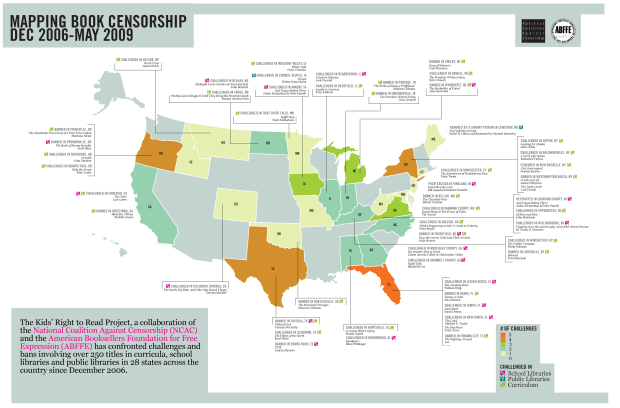What would a freshman English class be without Of MIce and Men? No George or Lenny? People in Appomattox, Virginia seem to think it’d be just fine.
The National Coalition Against Censorship, however, has different ideas on the matter. For the past couple of years the NCAC has confronted such bans and challenges from libraries and curricula. Above is a map of bans and challenges over from December 2006 to May 2009. Other notable works include The Golden Compass, Girl, Interrupted, and yes, brace yourself, The Adventures of Huckleberry Finn.
[via DataViz]


 Visualize This: The FlowingData Guide to Design, Visualization, and Statistics (2nd Edition)
Visualize This: The FlowingData Guide to Design, Visualization, and Statistics (2nd Edition)

Wow! This ought to be over on the Junk Charts blog.
The aggregation of challenges and bans by state, rather than by county, encourages a stereotyped interpretation of regions. Furthermore, the lack of any time spans suggests that the NCAC doesn’t give credit to anyone who retracts a ban in a 3-year period. Finally, what’s up with Idaho and Missouri? Every other shaded state gets a bad example; these two just get dissed without any supporting evidence at all! It’s not like there wasn’t room on the graphic.
@Mike – you’re totally right. i’d go a step further, and not even bother color-coding states or counties and just keep it at the city-level with pointers. The color-coding in itself is kind of weird.
I think this is one of those graphics that is communicating a worthy cause, but the extremity is a bit exaggerated.
So how else can we improve this map? I can think of quite a few other ways.
Pingback: Ensaio (mÃnimo) sobre a preguiza » Enlaces varios
The Perks of Being a Wallflower is also misspelled.
The map reads “Berks” instead of “Perks.”
Texas, New York and Florida are 3 of the 4 most populous states. Since these states have the greatest number of people, it stands to reason that they have the greatest number of book challenges.
Texas’ population is 24 times greater then Montana, so it makes sense that Texas has more book challenges then Montana.
My argument doesn’t always make sense when comparing other states. Oregon stands out (27th state in terms of population, but top of the list for number of book challenges).
Also, maybe some of these states didn’t have any book challenges between 2006-2009, because some books were already banned before 2006.
-= Stefan
@Stefan:
Good observation! I suspect that the variation you’ve noticed is essentially random and could be handled by using a Poisson model with a mean of rp, where r is the national average “ban rate” and p is the state population. Sounds like a good problem to give my statistics students…I’m off to the NCAC website for more data.
rather than titling it “Mapping book censorship” a more accurate title would be “mapping book challenges” rarely is a book censored or banned in this country. one can find a copy somewhere
The problem with book challenges is they often highlight and promote the focus of the challenge. Witness Salman Rushdie’s “Satanic Verses.” Or that “The Earth, My Butt, and Other Big Round Things” is now on my Amazon wish list (I like to reward creative titles).
I’m not sure I buy the population-lead-to-challenges argument. Texas may have more people than Montana, but does it actually have more potential book titles? The more likely effect is that, assuming each “challenge” is specific to a school system or library system, more populous states may offer more venues in which to lodge a challenge.
Pingback: Midday open thread | The Latest Liberal Blogs
Pingback: You are not allowed to read this book « Kristin Nicole
The color scale should be changed to discrete, separately identifiable colors: blue, yellow, green, red, purple or orange. The 4’s and 5’s are running together and I cannot distinguish between them sometimes. I also think state lines should be added. Interesting graphic and great cause but the details need work.